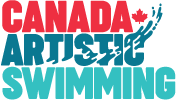As one door closed, others will open for Synchro Canada
in the next two quadrennials as it maps out an eight-year strategy including a focused four-year high performance plan leading into the 2020 Olympic Summer Games in Tokyo, Japan. In the midst of the heartbreaking disappointment earlier this year in Rio, where Team Canada missed out on the final Olympic team berth by less than a point, the positive feedback received was very encouraging
“Many people in the synchronized community admired how much our team had improved,” said Meng Chen, Team Canada Head Coach.
“It was very evident that our hard work since the world championships in 2015 was seen in the overall presentation of our two performances. People appreciated the power in our team and the discipline in their approach to training. Our highlight elements were both the strongest, and the most difficult in the competition. We credit our use of performance analysis techniques that allow us to focus in a targeted way on developing those various aspects of our routines.”
The work of the team and coaches since last August pushed Team Canada past the team from Spain for the first time in almost a decade, and saw them challenge the remaining three teams to qualify. It was an unusual situation that caused the Canadians to have to qualify for the 2016 Olympic Games outside of their continental championship.
For the team competitions, the best ranked country in each of the five continental championships, secured a direct entry for the Games. Egypt qualified for Africa, China qualified for Asia, Russia for Europe and Australia for Oceania. The exception was the Pan American continent – where Brazil received the berth as the Olympic host country even though Canada won the Pan American Games gold medal, which would normally have served as the qualifying meet.
That left Canada having to compete for one of the three remaining entries at the Olympic Qualification Tournament. Ukraine and Japan qualified 1, 2 and Italy just edged out Canada for the 8th and final position. Canada’s duet qualified directly for the Games by winning the gold medal at the 2015 Pan American Games.
Synchro Canada wants to continue working with FINA to ensure the best teams in the world qualify for the Olympic Games in 2020. Given the depth of talent, and the closeness of the top teams, Canada is supporting a change to the Olympic selection criteria that would allow the top 10 or 12 teams in the world to qualify for the Games. There is discussion at the International level around the introduction of an annual World Cup Circuit event series. The suggestion has also been made that Olympic qualifying could be based partially on continental representation and partly on world ranking. If approved, the World Cup Circuit could begin in 2017.
Team Canada is already preparing now for its next major event, the 2017 FINA World Championships, to be held in Budapest, Hungary in July next year.
Looking further ahead than 2017, Synchro Canada knows that future international success starts at the grassroots level across the country. Work is underway to introduce a more standardized training approach for synchronized swimmers at the entry level. Building on its recently revised Long Term Athlete Development Model, changes will be made at this development level to better prepare synchro swimmers as athletes first, focussing on physical literacy and fundamental skills. This enhanced next gen training structure, plus passionate young athletes will ensure that Canada continues to advance its goal to place the next generation of synchronized swimmers on world and Olympic podiums in the years to come.


